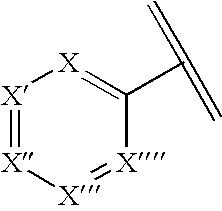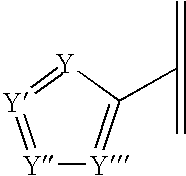N-aryl azaspiroalkene and azaspiroalkane compounds and methods of preparation and use thereof
a technology of azaspiroalkene and azaspiroalkane, which is applied in the field of naryl azaspiroalkene and azaspiroalkane compounds, can solve the problems ofnicotinic compounds and various undesirable side effects, and achieve the effect of alleviating pain and reducing particular disorders
- Summary
- Abstract
- Description
- Claims
- Application Information
AI Technical Summary
Benefits of technology
Problems solved by technology
Method used
Image
Examples
example 1
Synthesis of 1-aza-8-(3-pyridinyl)spiro[4.5]dec-7-ene trifluoroacetate
[0383]1-aza-8-(3-pyridinyl)spiro[4.5]dec-7-ene trifluoroacetate was prepared in accordance with the following techniques:
[0384]1-Azaspiro[4.5]decan-2,8-dione ethylene ketal was made as described in Org. Lett. 3(15): 2353-2356 (2001).
1-Azaspiro[4.5]decan-8-one ethylene ketal
[0385]A solution of 1-azaspiro[4.5]decan-2,8-dione ethylene ketal (5.00 g, 23.7 mmol) in dry THF (100 mL) was added to lithium aluminum hydride (0.90 g, 23.7 mmol) under argon. The mixture was refluxed for 8 h and cooled to 0° C., whereupon aqueous sodium hydroxide (5 M), sufficient to decompose the remaining hydride and produce a granular precipitate of aluminum salts, was added. The mixture was filtered, and the filtrate was concentrated by rotary evaporation, leaving 4.50 g (96%) of a viscous, colorless oil.
Ethyl 1-azaspiro[4.5]decan-8-one-1-carboxylate
[0386]Ethyl chloroformate (1.90 mL, 2.16 g, 19.9 mmol) was added drop-wise to a cold (0° C....
example 2
Synthesis of 1-aza-8-(5-isopropoxy-3-pyridinyl)spiro[4.5]dec-7-ene trifluoroacetate
[0389]1-Aza-8-(5-isopropoxy-3-pyridinyl)spiro[4.5]dec-7-ene trifluoroacetate was prepared in accordance with the following techniques:
5-Isopropoxy-3-pyridinylboronic acid
[0390]To a stirred, −78° C. solution of 2.5 M n-butyllithium (44.0 mL, 110 mmol) in toluene (120 mL) was slowly added a solution of 3-bromo-5-isopropoxypyridine (21.6 g, 100 mmol) in toluene (40 mL) while maintaining the temperature below −50° C. After the addition was complete, the reaction was stirred at −78° C. for 30 min. Distilled THF (40 mL) was added, and the reaction stirred for 15 min at −78° C., followed by the addition of triisopropylborate (27.7 mL, 120 mmol) in one portion. After warming to −15° C., the reaction was quenched with 1M HCl (260 mL), and stirred for one hour. The mixture was then neutralized (to pH 7) with 5 M NaOH and extracted with THF (4×100 mL). The combined extracts were dried (Na2SO4), filtered and conc...
example 3
Synthesis of N-methyl-1-aza-8-(5-isopropoxy-3-pyridinyl)spiro[4.5]dec-7-ene trifluoroacetate
[0394]N-Methyl-1-aza-8-(5-isopropoxy-3-pyridinyl)spiro[4.5]dec-7-ene trifluoroacetate was prepared in accordance with the following techniques:
N-Methyl-1-aza-8-(5-isopropoxy-3-pyridinyl)spiro[4.5]dec-7-ene trifluoroacetate
[0395]1-Aza-8-(5-isopropoxy-3-pyridinyl)spiro[4.5]dec-7-ene trifluoroacetate (30 mg, 0.077 mmol) was dissolved in a mixture of 98% formic acid (1 mL) and 37% aqueous formaldehyde (0.2 mL). The mixture was refluxed for 3 h, cooled and neutralized with saturated aqueous sodium bicarbonate, saturated with sodium chloride and extracted with chloroform (5×5 mL). The chloroform extracts were dried (Na2SO4) and concentrated by rotary evaporation. High-pressure liquid chromatographic purification of the residue on C18 silica gel, using a gradient of acetonitrile in water (0.1% trifluoroacetic acid), gave 22 mg (71%) of viscous, light brown oil.
PUM
 Login to View More
Login to View More Abstract
Description
Claims
Application Information
 Login to View More
Login to View More - R&D
- Intellectual Property
- Life Sciences
- Materials
- Tech Scout
- Unparalleled Data Quality
- Higher Quality Content
- 60% Fewer Hallucinations
Browse by: Latest US Patents, China's latest patents, Technical Efficacy Thesaurus, Application Domain, Technology Topic, Popular Technical Reports.
© 2025 PatSnap. All rights reserved.Legal|Privacy policy|Modern Slavery Act Transparency Statement|Sitemap|About US| Contact US: help@patsnap.com



